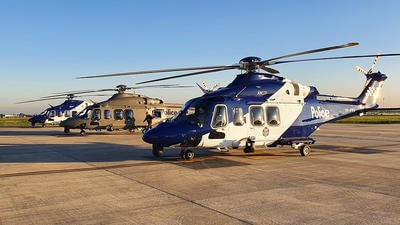Tactical airborne operations and mission critical communications

Critical communication innovation for first responder agencies in the age of data
Effective communication is essential for airborne emergency service providers, allowing air and ground-based first responders to deliver effective and coordinated responses using common trunked-mode networks such as Terrestrial Trunked Radio (TETRA) and P25. Currently, voice channels deliver the secure, guaranteed quality of service communication necessary. However, high-rate data communications are now becoming essential for terrestrial first responders and the air assets that support them. Data communications in the air provides first responders with ongoing access to online information in real-time from their Tethered Portable Electronic Devices (TPEDs), which greatly enhances their mission capabilities.
This new data service is being provided by new 4G/LTE-based Critical communication innovation for first responder agencies in the age of data Tactical airborne operations and mission-critical communications radio systems, which will enhance or replace TETRA infrastructures worldwide.
For several decades, Chelton has provided mission-critical communications for airborne users. In collaboration with the UK Home Office and Police, it pioneered the application of TETRA for airborne use to provide Mission Critical Push to Talk (MCPTT) communications between ground and air users.
As its name suggests, TETRA is primarily a terrestrial system. Chelton and its customers learned the lessons required to integrate this capability into an airborne system, including the use of Highly Preferred Subscriber Class and the need for a dedicated TETRA air-cell overlay. Airborne TETRA systems provide essential communications on more than 500 aircraft worldwide, including aircraft operated by police, air ambulance, military, coastguard, and other government departments.
Aircraft OEMs, design organizations and end users install Chelton’s avionic-standard TETRA systems because it is designed and environmentally qualified for airborne use. The new Aircraft Communication System (ACS) now includes Control Display Units (CDU), which come in two sizes to suit different aircraft requirements and number of communication channels and also has a human machine interface designed specifically for aircrew operation, including touch-screen and night vision capability and compatibility with aircraft audio control systems.
This may be installed with multiple transceivers and CDUs, and its dedicated antennas support end users' UHF and GPS radio frequency requirements.

However, as international public safety communication requirements evolve, governments and end users' are moving to augment and potentially replace their TETRA networks to take advantage of high datarate systems, especially 4G/LTE, in order to increase functionality whilst maintaining the secure communications and guaranteed Quality of Service (QoS) that TETRA provides.
provides. The UK is pioneering this approach through its Emergency Services Mobile Communications Programme (ESMCP), which will replace the Airwave TETRA network with a national 4G/LTE public-safety communications system. In 2019, the UK Home Office selected Chelton to develop and supply the ACS, a new form/fit LTEbased replacement for the current airborne TETRA systems used on the dedicated Airwave TETRA network.
The ACS will support the Emergency Services Network (ESN) LTE, Airwave TETRA communication capability and VHF communications. Each ¼ ATR transceiver unit will now support two radio channels, either dual LTE, dual TETRA or TETRA + VHF and can be fitted in combinations to suit the needs of the users. The ACS delivers secure voice over TETRA and LTE as well as high-rate data communications over LTE and supports ‘hotspot’ tethering of electronic devices using Ethernet, Wi-Fi and Bluetooth. Chelton’s aeronautical antennas and complementary radio RF designs optimize performance on the TETRA and LTE networks to maximize range and throughput, whilst minimizing the number of antennas required for LTE, TETRA, VHF and GPS.
A key benefit of this system is its modularity, flexibility and ease of installation, making it suitable for international use and creating a stepped route from airborne TETRA, through to TETRA/LTE hybrid systems to full LTEbased Mission Critical Push-To-Talk. The next generation data communications service supports first responder needs, as well as enabling the ACS and network performance to be continuously monitored and for ACS software to be updated over-the-air to enable rapid deployment of new enhancements to all the deployed ACS in the operational fleet of aircraft. The ACS will thus be futureproof and adaptable to the evolving needs of the first responder community.
For more info on Chelton’s Mission Critical Communications suite, go to https://www.chelton.com/our-capabilities/avionics/mission-critical-ptt/

July 2022
Issue
In our July Police Aviation issue of AirMed&Rescue, we look at training and simulation excellence across this special mission sector.


